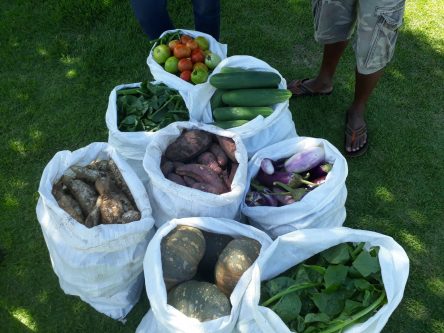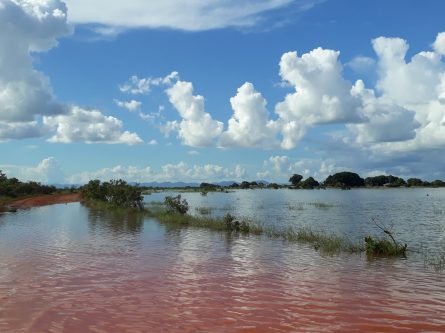The recent flooding of the Rupununi, Region 9 will now see the Santa Fe mega farm seeking “higher lands” for its cattle expansion project, even as it awaits government’s go ahead for an additional 20,000 acres of land.
“The heavy rainfall has flooded the lower part of the first area fenced for cattle and has also inundated most of the second area earmarked for cattle, that is the area along the Hunt Oil stretch, where fencing was done with the goal of rearing a significant amount of cattle,” Director of Santa Fe Farms, Richard Vasconcellos told Stabroek News in an interview.
“With most of that area flooded with water reaching levels of more than a meter, consideration has to now be given to acquiring land with higher grounds, since it will be a challenge during seasons of heavy rainfall to keep a big herd of cattle on the few high grounds available in that area,” he added.
Last December, the Director of the Santa Fe Complex, had shared with this newspaper future plans for the farm, during a visit to the 29,000-acre complex. He had explained that after six years and an investment of over $1.3B to date, they were awaiting government’s go ahead for an additional 20,000 acres of land to begin cattle rearing early this year. Once the lands were approved and the cattle rearing commenced it would have completed the first phase of the project for the complex.
“Early next year we are looking to complete an agreement with government for the lease of another 20,000 acres of land as we keep pushing aggressively ahead,” he had said.


Further, he added “We are really moving now. We have done our rice, we are comfortable with our yields and we are now going into our cattle programme aggressively. We are also looking to bring in some black belly rams from Barbados as we continue with our sheep programme…and that would complete phase one.’
The project, founded by prominent Barbadian investor, Sir Kyffin Simpson, who owns the Interamerica Trading Corporation that is responsible for the investment at Santa Fe, has seen the transformation of 29,000 acres of land that many had bypassed and called barren, now producing myriad crops, including rice for export to neighbouring Brazil.
And with government also promising the region a new abattoir sometime this year, Santa Fe Farms officials were moving to simultaneously acquire the lands needed and complete the first phase of a proposed three-phase agricultural development project with cattle rearing.
“We have always modelled as a large scale integrated farm. We are in phase one and we are moving aggressively towards cattle which would complete that phase. We have completed our studies and … it has been determined that we would need grazing land. Unfortunately the grazing lands where Santa Fe is located is not of the best quality. So as a consequence to that, one would require expansive grazing lands. Of course there is situations for pasture enhancement, but in our business model, pasture enhancement is very costly. You see, to plant certain types of grass to improve the pasture, our business model would not allow us that.
“We are looking forward to the new abattoir. The government has indicated that Lethem would be getting again its own new abattoir and we are excited for that. But of course, it would take a couple of years before we can get to a size of herd, to that point, where we can supply it. Nonetheless, we are moving towards that and are hoping to be if not the main supplier then one of the main suppliers,” Vasconcellos had said.
‘Seriously threatened’
But heavy rainfall, with days of constant rain at night, both in the Rupununi and on the Brazil border, saw several villages in Region 9 flooded, even forcing the evacuation of some residents. It has since been revealed that there has been heavy rainfall in Brazil which caused overtopping of the Ireng and Takutu Rivers.
Vasconcellos pointed out that its cattle rearing project now rests on the lands promised by government.
“Santa Fe has been waiting for additional acreage for cattle grazing under the MOU with Government and this flooding has demonstrated that without this land the continued viability of Santa Fe is seriously threatened…we are still awaiting an affirmative response from the Government of Guyana, he stated.
However, while the cattle expansion has been threatened by the floods and the agro-industrial operations affected, the farm’s rice crop was spared.
Fruits and vegetables were not as heavily affected as it was reaping season for most vegetables. As such the farm’s management decided that instead of selling the crops it would donate all to affected residents of Lethem.
The problem came with transportation, as exporting rice it had produced to Brazil and getting the vegetables to the town of Lethem proved impossible.
“The rice crop has been spared. As management, with foresight and knowledge of the topography of the area, carried out extensive land surveying. They had selected areas suitable for rice cultivation and complemented these with several kilometers of drains on the lower ends of the fields to take the excess water to sedimentation ponds,” he explained.
“The farm is currently waiting on the condition of the road to improve before produce can be sent to Lethem…approximately seven kilometers from the farm heading to Lethem the water from the Ireng River has been flowing across the main road causing erosion of the laterite. Part of the road approaching the Pirara Bridge is inundated with water and has reached levels of 3-4 ft., limiting the type of vehicles that can cross to reach Lethem. Other parts of the road, between the Pirara Bridge and Wikin ranch, are also flooded but the water level is not as high as the Pirara bridge approach. We have recognized that other areas are also seriously affected by the rains and subsequent flooding. Accordingly we contacted officials of the Disaster Relief Committee and have offered to donate rice, vegetables and ground provisions to the flood relief shelters that have been set up as well as to the hospital at Lethem. Santa Fe has also offered to render assistance with its equipment at the Pirara Bridge and Hunt Oil stretch of road, both of which areas are flooded,” he added.
The Santa Fe Director pointed out that exacerbating the difficulty in travelling by vehicle was that some of the trucks taking cargo to Lethem have made some deep holes on the flooded parts of the road when they were stuck. Thus, smaller vehicles cannot manoeuvre and are themselves now getting stuck in the very holes.
But workers at the farm have promised unwavering support to residents of the region as they are their primary customers.





